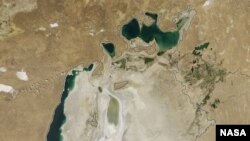The numbers are disturbing and the situation potentially dire.
According to the United Nations, the global demand for water is expected to rise by 400 percent by 2050.
And figures released earlier this year by the Twente Water Centre in the Netherlands concluded that 4 billion people live under conditions of what they call "severe water scarcity" at least 1 month out of every year.
More Trouble on the Way
But a new survey by researchers at the Massachusetts Institute of Technology (MIT) says that a combination of changing climate and population growth will add a billion people to that total, in Asia alone, over the next 35 years.
The new research is being published today in the journal PLOS One and the authors stress that it isn't just another scary story about the effects of climate change.
It's about growth, both in the industrial world and in the general population.
"It's not just a climate change issue," says Adam Schlosser, a co-author of the study and a senior research scientist at MIT. "We simply cannot ignore that economic and population growth in society can have a very strong influence on our demand for resources and how we manage them."
He also told VOA that these effects are worldwide.
"Previous research over Africa" he said, "indicate much of the same trends in risks that we have underscored for eastern and southern Asia."
The researchers did some very cool modeling for their research, building models that took account, not only population growth, but also industrial growth, and climate change.
What they discovered is that in China, industrial growth is putting the biggest stressors on the water supply.
In India, it's rapid population growth that is going to lead to more water shortages.
Long Ranging Geographic Effects
"Climate, on top of that, can lead to substantial magnifications to those stresses," but Schlosser says gauging that impact is more difficult. "Climate change" he told VOA, "can be benign or even act to offset the increased stress induced by a growing population and economy."
On the other hand, a water shortage in one place can cause trouble farther away because the water has to come from somewhere.
In many cases, basins unaffected by any of the pressures the researchers studied are at risk because of extra demand from nearby hard-hit regions.
What To Do?
The coming worldwide lack of water is a problem that organizations as varied as the U.S. Defense Department and investment management companies are actively preparing for.
In fact, a recent survey of investment management companies showed that 90 percent are incorporating water resource strategies into their business models. And over 80 percent are working to reduce their own water use.
The MIT researchers are now studying ways to help lessen the impacts of water shortages.
While the research is ongoing, Schlosser tells VOA their computer models indicate that little changes can have a big impact. Something as simple as improving the efficiency of irrigation techniques on a large scale can make a difference. Global climate mitigation efforts can result in a measurable decrease in the risk of water stress.
Schlosser hopes to publish the new research soon.







